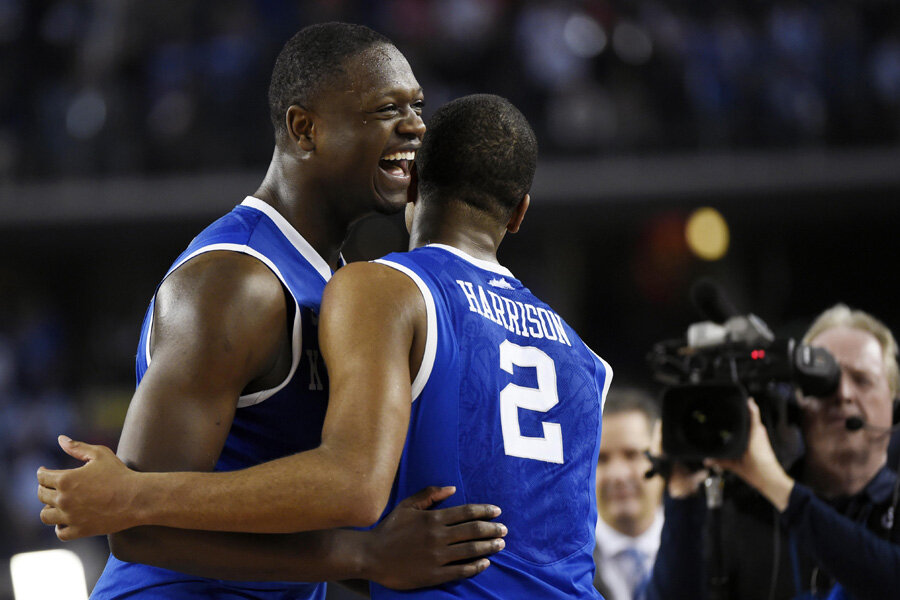UConn and Kentucky demonstrate resolve in reaching NCAA championship game
Loading...
| Boston
The University of Connecticut Huskies and the University of Kentucky Wildcats, seeded 7 and 8 respectively, have reached Monday night's NCAA men’s basketball tournament championship game at AT&T Stadium in Arlington, Texas. Connecticut’s 63-53 win over the Florida Gators was a defensive clinic, while Kentucky’s 74-73 win over the Badgers of Wisconsin was a nail-biter that had Aaron Harrison hitting yet another game-winning three-pointer at the buzzer. It is the lowest combination of seeds playing in the national championship (15) since the seeding process began in 1979.
UConn gained its trip to Monday night’s championship game by playing inspired defense, holding top-seeded Florida to 17 points below its season average of 70. In the opening minutes, the Gators raced off to a 16-4 advantage, largely bolstered by their full-court pressing of UConn’s guards. But within 90 seconds of that, UConn had cracked the Gators’ code and narrowed the gap to 16-15 - bookended by two three-pointers from DeAndre Daniels, who hit for 20 points on the night. It seemed to genuinely stun the normally hard-charging Gators, who never really recovered their poise after that.
Having already beaten Florida in December (two of Florida’s three losses on the season came at the hands of the Huskies), UConn understood that solving the Gators’ outstanding guards, Michael Frazier II and Scottie Wilbekin was the secret to winning, together with applying pressure on the Gators’ big man inside, Patric Young (19 points). Wilbekin and Frazier combined for an uncharacteristic seven points, with only 1-10 from three-point range. The Gators were also held to only three assists to the Huskies’ 11. And four of Florida’s 11 turnovers came at the hands of their ordinarily nimble backcourt of Wilbekin and Frazier.
Aside from Young’s 19 point night, the Gators had good production from forward Casey Prather, who hit for 15. But the night belonged to Connecticut’s offensive trident of Daniels and guards Shabazz Napier and Ryan Boatright, who combined for 45 points, including 5 of 12 shots from beyond the arc. Daniels had a double-double on the night, adding 10 key defensive rebounds to his twenty-point offensive effort. Saturday’s win was a reassuring development for UConn which, having needed overtime to defeat St. Joseph’s in its first round, has gained confidence in both its pressure defense and its perimeter offense.
Later on Saturday evening, the second-seeded Wisconsin Badgers maintained a small but persistent lead over Kentucky through the first half, and into the second. But this game belonged to the Wildcats’ Aaron Harrison, who canned his third clutch 3-pointer in as many games―this one coming with 5.7 seconds remaining to deflate the Badgers (30-8), whose star guard, Traevon Jackson, hit back-iron with a last second field goal attempt. Kentucky has won its five NCAA tournament games by a combined total of 18 points.
During the play immediately preceding, Jackson had been fouled by Aaron’s twin brother, Andrew Harrison, while attempting a three-pointer from the top of the key. And though Wisconsin set an NCAA record by hitting 19 of their 20 free throws (95%), the first one of three that Jackson attempted rimmed out. After making the other two shots, the game stood at 73-71, setting the table for Aaron Harrison’s heroics.
Kentucky’s big men had keyed on Wisconsin’s prolific scoring center, Frank Kaminsky, essentially making him a non-factor for the first half, and for the night, he hit for a mediocre eight points, supplemented by only five rebounds. But what Kaminsky failed to do offensively was compensated for by an extraordinary performance by reserve guard Bronson Koenig, who scored 11 points in 20 minutes on the floor. He rounded out a foursome of Badgers in double figures, led by forward Sam Dekker and backcourt starter Ben Brust, who tossed in 15 apiece, with Traevon Jackson notching 11.
Kentucky’s offense was not as backcourt-heavy, as it was with UConn earlier in the evening. But Aaron Harrison has proven himself the man you want to give the ball to at the end of the game. This freshman-heavy Wildcat squad’s scoring attack was rounded out by center Dakari Johnson, guard James Young and forward Julius Randle, who combined for 43 points in denying the Badgers their first trip to the final since 1941. And in going for their second title in three years, Kentucky and their coach John Calipari have completely turned around what was, just four months ago, a foundering program and returned it to pre-eminence in NCAA basketball.
[Editor's note: Ryan Boatright's name was misspelled in the original version of this story.]







